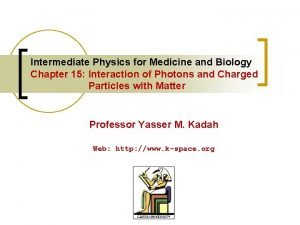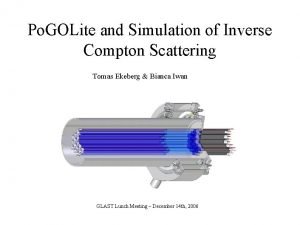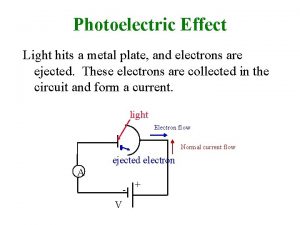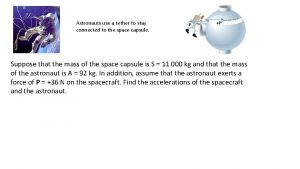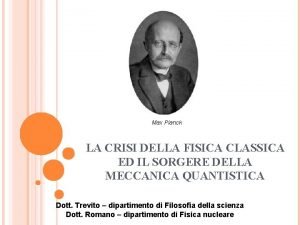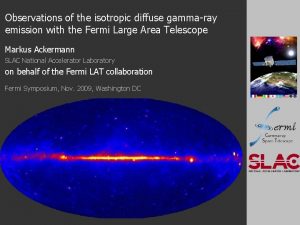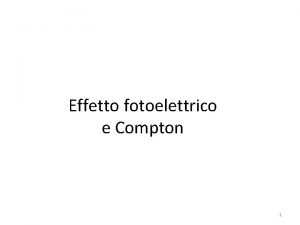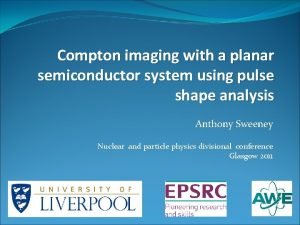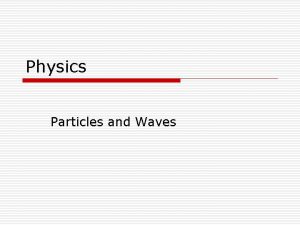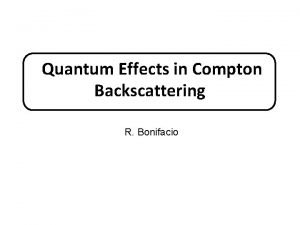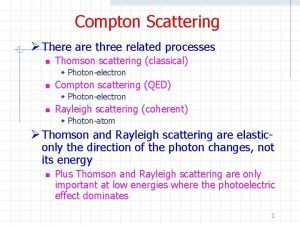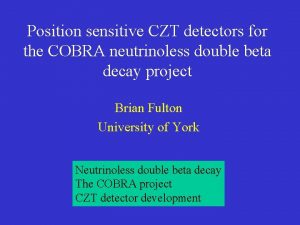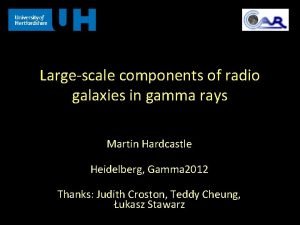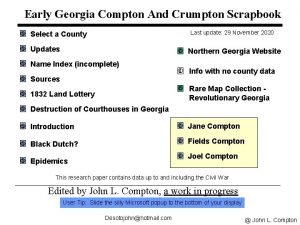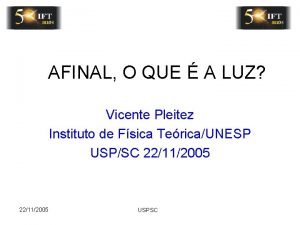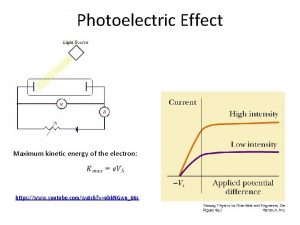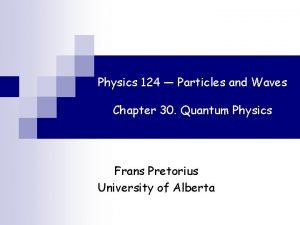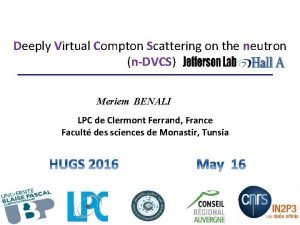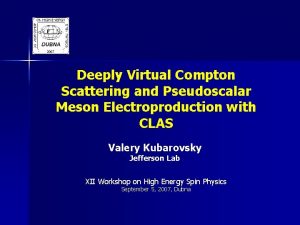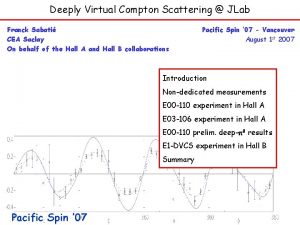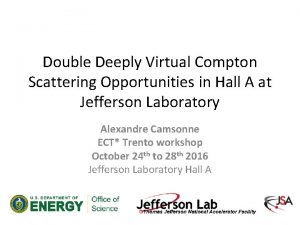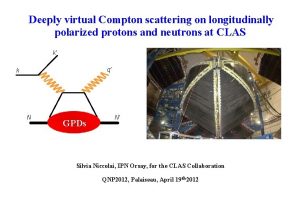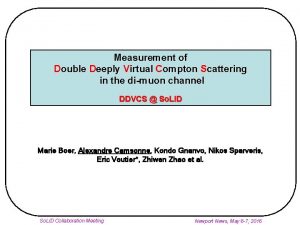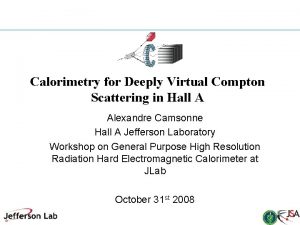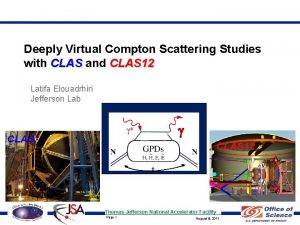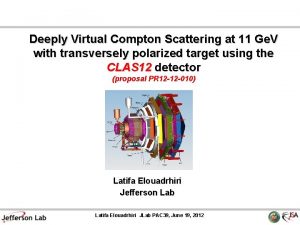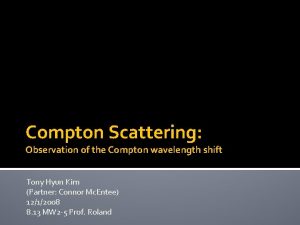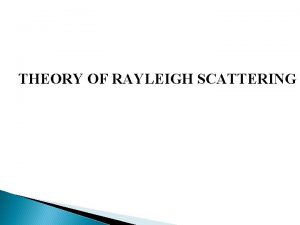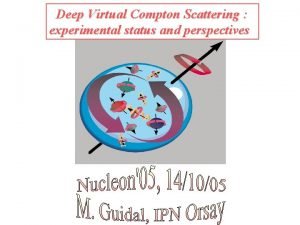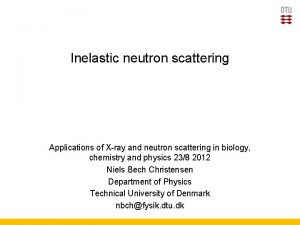Deeply Virtual Compton Scattering on the neutron at
























- Slides: 24

Deeply Virtual Compton Scattering on the neutron at Jefferson Lab Hall A 2010 n. DVCS MERIEM BENALI June 6, 2016

Introduction / Motivation DVCS (Deeply Virtual Compton Scattering) is the simplest hard exclusive process which can be described in terms of GPDs by measuring its cross section. Goal: Extraction of unpolarized DVCS cross section off the neutron Hard part (calculable) Soft part (parameterized by GPDs) üEbeam= 4. 45 Ge. V & 5. 54 Ge. V üQ² = 1. 75 Ge. V² ü x. Bj = 0. 36 ü t ~ [-0. 5 , -0. 1] Ge. V 2 2

Theoretical aspect Known term Real part Imaginary part The unpolarized cross section accesses the real part of DVCS and the |TDVCS|2 term which are sensitive to an integral of GPDs over x The polarized cross-section accesses the imaginary part of DVCS and therefore GPDs at x=±ξ

Total cross section GPDs The unpolarized cross section (using the Belitsky and Mueller formalism) Interference A. V. Belitsky, D. Mueller Phys. Rev. , D 82: 074010, 2010 The observable is a linear combination of form factors and Compton form factors : Compton form factors(CFFs) (are combinations of GPDs) Since F 2> F 1 for the neutron: GPD 4

Experimental apparatus ’) k e’( γ(q’) P(p’) Recoil nucleon not detected Electromagnetic Calorimeter • 13 x 16 Pb. F 2 blocks (Čerenkov light detection) • Block size: 3 x 3 cm² x 20 X 0 • Short radiation length : ->X 0=(1/20) crystal length • Molière radius = 2. 2 cm 5

Calorimeter energy calibration Calibration method e. N e’ π0 N γ 1 γ 2 (Detected) The calibration method is based on the comparison between the measured energy of a detected π0 from H(e, e’ π0)p events and its expected energy calculated with its scattering angle: ? ? Sum over all events After the minimization we get the calibration coefficients for each block i Sum over all blocks Calculated energy of pion measured energy in one block (elastically calibrated) Calibration coefficients The momentum of π0 reconstructed using Several iterations to get the final coefficients for each block i 6

Selection of the n-DVCS events Accidentals subtraction && π0 contamination subtraction The raw data: detect e’ and γ in coincidence ( e. N e’ γ X) • 1 track in the HRS and 1 cluster in the calorimeter (energy> 1 Ge. V) The detected photon may be in fortuitous coincidence with the scattered electron The photon detected in the calorimeter may come from the decay of π 0 and resembles kinematically to a DVCS photon : e. N e’π0 X e’ γ 1 γ 2 X threshold Pion production 7

Selection of the n-DVCS events After • subtracting the accidentals, • subtracting single photons coming from π0 decay (π0 contamination), • adding Fermi momentum to H 2 data, ____ D(e, e’γ)X - acc - π0 cont • normalizing H 2 and D 2 data to the same luminosity, ____ H(e, e’γ)X – acc - π0 cont we obtain the difference (D(e, e' γ)X- H(e, e' γ)X ) ____ D(e, e’γ)X-H(e, e’γ)X Ebeam=4. 45 Ge. V Exclusive cut Ebeam=5. 54 Ge. V Exclusive cut MX 2 = 0. 95 Ge. V² MX 2 (Ge. V 2)

Adjusting the simulation to the experimental data Experimental data obtained + simulated data: 1 - have the same cuts applied to the experimental data 2 - have the same resolution and the same calibration as experimental data Simulated data Adjustment : Experimental data Cross Section 9 9

Smearing of the simulation data Method: . for 1 bin in (t, φ) • Smear only the photon energy in the simulation data because the experimental resolution is dominated by the energy resolution of the calorimeter • Smearing process is applied by bin in t and φ (same binning as σ exp extraction) fit of the simulation data by a Gaussian fit of the experimental data by a Gaussian E(Exp-th) (E(MC-th) ) The photon energy in the simulation is smeared by: 10

Smearing of the simulation data Smearing Result for 1 bin in (t, φ ) Simulation before smearing Simulation after smearing Experimental data 11

Extraction of the cross section The unpolarized (n. DVCS + d. DVCS) total cross section (simplified expression) : A. V. Belitsky, D. Mueller Phys. Rev. , D 82: 074010, 2010 Binning : ü 4 bins in t (transfer t) ü 20 bins in φ : Dependence in φ Separate the different neutron contributions (or coherent deuton contributions) __n-DVCS simulation __d-DVCS simulation ü 30 bins in MX² : Binning in Mx 2 Separate contributions Xin from Xid: Mx²d ≈ Mx²n+t/2 ü 2 bin in Ebeam: Rosenbluth separation based on data taken with two beam energies. (We used the same observables Xin and Xid to fit the Data at Ebeam=4. 45 and Ebeam=5. 54 Ge. V data) ≈Mn²_neutron ≈Mn² + t/2

Extraction of the cross section A χ² minimization between the smeared simulation data and experimental data: Number of experimental events in one bin k The statistical errors in one bin k Number of events in the simulation in one experimental bin e Number of events in the simulation in one Vertex bin v migration probability of an event at the vertex “v” to an experimental bin “e” 13

n-DVCS cross section (+d-DVCS) Ebeam=4. 45 Ge. V t_n=- 0. 41 Ge. V² t_d=-0. 33 Ge. V² Ebeam=5. 54 Ge. V <t_n>=-0. 41 Ge. V² t_n=-0. 31 Ge. V² Systematic errors of σexp Y R A N I M I L E PR t_n=-0. 25 Ge. V² σ exp (with statistical errors) t_d=-0. 26 Ge. V² t_d=-0. 20 Ge. V² σ(total fit) A. V. Belitsky, D. Mueller Phys. Rev. , D 82: 074010, 2010 total neutron contribution total deuton contribution Ø Total cross section is small at large | t | ØThe neutron contribution is seems to be dominant (especially at high | t |) 14

(n-DVCS +d-DVCS) cross section Experimental cross section, neutron contribution and deuton contribution < t >=-0. 41 Ge. V² , MX²<0. 95 Ge. V² Y R A MIN I L E PR Ø At high |t| : - The neutron contribution (blue band) dominates the total cross-section - The deuteron contribution is almost compatible with zero - This is the first experimental evidence of a positive n-DVCS contribution since the total neutron contribution (blue band) is higher than the neutron Bethe 15 Heitler (blue dotted lines)

Conclusion • Adjustment of the resolution and the calibration of the simulation relatively to the experimental data • Rosenbluth separation and Extraction of the preliminary experimental cross section (neutron + coherent deuton) for two beam energies. • The incoherent n-DVCS contribution is positive at high |t| for both beam energies • The coherent d-DVCS contribution is compatible with zero at high |t| for both beam energies • Complete study of systematic error by looking at variation of the cross section according to the missing mass cut. 16

THANK YOU FOR YOUR ATTENTION 17

18

Observables: 3 Xi = Re(CI) , Re(CIFeff) , CDVCS Y R A N I M I L E PR 19

Calorimeter energy calibration Calibration result Invariant mass peak position § Minv before calibration * Minv after calibration Kin 2_low Kin 2_high (Missing mass)² peak position § M²X before calibration * M²X after calibration Kin 2_low Kin 2_high M(π0)≈ 0. 135 Ge. V M²p≈ 0. 88 Ge. V² After the π0 calibration we reproduce: the π0 mass & the proton mass Each group number corresponds to 1 or 2 days of data taking This method allows a daily calibration of the calorimeter 20

Extraction of the cross section Binning : 4 bins in t (squared momentum transfer)× 20 bins in φ Events number in the simulation in one bin at the vertex luminosity solid angle differential cross section kinematic variables The unpolarized (n. DVCS + d. DVCS) total cross section (simplified expression) : BH _neutron BH_coherent deuteron contribution Kinematical (DVCS²+I) neutron factor Contribution Calculated with elastic form factors Dependence in φ Separate the different neutron contributions Xin (neutron) (or Xid (coherent deuton)) Binning in Mx 2 Separate contributions Xin des Xid: Mx²d ≈ Mx²n+t/2 (DVCS²+I) Coherent deuteron Contribution ___ n-DVCS simulation ___d-DVCS simulation The observables we want to extract: these are linear t/2 combinations of CFFS which contains GPDs (unknown) ≈Mn² + t/2 ≈Mn²_neutron 21 A. V. Belitsky, D. Mueller Phys. Rev. , D 82: 074010, 2010

Aspect théorique ØUne décomposition des termes |TDVCS|2 et I(BH. DVCS) suivant l'angle φ Terme connu 22

Aspect théorique ØChaque harmonique se décompose en une série d’observables à extraire Terme connu 1 2 9 Contributions !! ( we can’t fit everything) 3 23

A. V. Belitsky, D. Muller Phys. Rev. , D 82: 074010, 2010 In the new BKM Formalism we have: We chose to fit only 6 CFFs: Extraction of the cross section 9 CFFs for the neutron 9 CFFs for the coherent deuton 18 Contributions !! ( we can’t fit everything) 3 Xin = Re(CI)n , Re(CIFeff)n , Cn. DVCS AND 3 Xid = Re(CI)d , Re(CIFeff)d , Cd. DVCS BUT: These coefficients Xin and Xid are effective coefficients AND These coefficients are not stable (event if the χ² of the fit is good) as a function of: v. Cut on Mx² vthe binning on Mx² v. The number of contributions to fit Only the BH_contributions and the total experimental cross section will be shown 6/6/2021
 Compton scattering
Compton scattering Compton effect
Compton effect Golite trig 2
Golite trig 2 Photoelectric effect formula
Photoelectric effect formula Compton scattering vs photoelectric effect
Compton scattering vs photoelectric effect Suppose your car was mired deeply in the mud
Suppose your car was mired deeply in the mud To become deeply aware through the senses
To become deeply aware through the senses 2. 'foresight is deeply rooted within intuitive mind.'
2. 'foresight is deeply rooted within intuitive mind.' Compton olayi
Compton olayi Effetto compton
Effetto compton Isodosis
Isodosis Inverse compton
Inverse compton Carica elettrone
Carica elettrone Compton
Compton Compton scatter radiology
Compton scatter radiology Derivation of compton effect
Derivation of compton effect Compton backscattering
Compton backscattering Photoelectric and compton effect
Photoelectric and compton effect Compton
Compton Aeronet compton
Aeronet compton Ngc 6251
Ngc 6251 Keisoni
Keisoni Fóton
Fóton Photoelectric
Photoelectric Compton wavelength
Compton wavelength

